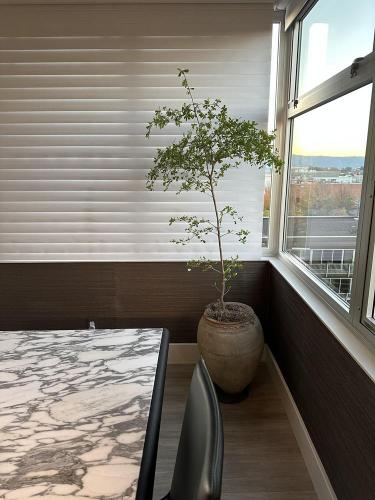There is no advantage, other than improved optics, to removing a stake from an indoor tree, but there is a distinct advantage in not staking outdoor trees, or staking them so they can still bend/flex, or removing the stake as soon as the tree is firmly anchored to the soil. Reason: Wind, absent indoors from a practical stance, is what causes trees outdoors to flex and bend. The deflection causes tiny cracks in the periderm (young bark) which causes synthesis of a growth regulator (ethylene). In turn, ethylene promotes thickening of flexing trunks and branches, and stimulates production of a complex organic polymer called lignin. Lignin, second only to cellulose as the most abundant organic compounds on earth, is what makes plants woody and gives then structural stability.
That the tree is leaning now is no big deal. You can very easily correct the lean when you next repot the tree.
One thing I noticed though, if the tree is actually planted in the large clay pot, I'd repot in spring because you'll have a great deal of difficulty removing the tree from the pot. If the clay pot is serving as a cache pot only, disregard. It is important though, to repot your tree regularly. A repot includes bare-rooting, root pruning, and a change of grow medium, and it relieves all stress associated with root congestion (being root-bound). Potting up to a larger size pot ensures most of the stress associated with root congestion remains as potting up leaves all root congestion at the center of the root mass. Starting your trees on a regular schedule of full repots while they are still very young makes repotting much easier as the tree ages.
FWIW, the reason bonsai trees can live for centuries and be passed down from generation to generation to generation, where most woody houseplants are usually in serious decline before their 5th birthday, lies in the way roots are cared for. It's a key element in the long term care of woody plants maintained in containers.
If you have interest, I can send you a couple of links to threads I started about long term care of trees in pots.
Al
